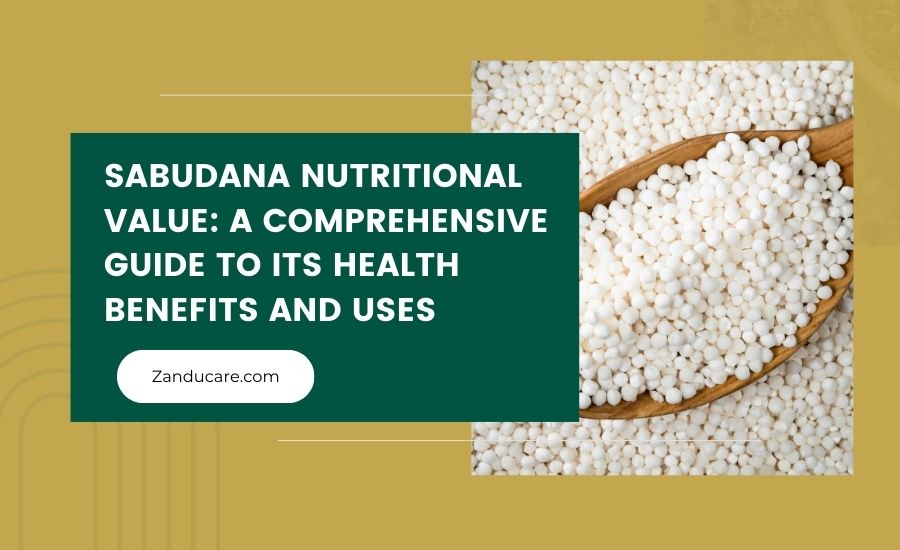
Sabudana Nutrients per 100g: Micronutrients, Calories & Carbs
|
Key insights:
|
Sabudana, commonly known as tapioca pearls, is a starchy food derived from the root of the cassava plant. Widely consumed in India, especially during fasting, sabudana is valued for its high carbohydrate content, which provides an instant energy boost. When soaked and cooked, these tiny white pearls transform into a chewy and translucent texture, making them popular in dishes like khichdi, vada, and kheer.
Sabudana's neutral flavour allows it to blend well with spices, vegetables, and sweet ingredients, making it a versatile addition to many traditional recipes.
Did You Know?
|
Nutritional Value of Sabudana

Here is the nutritional content of a one-cup serving of sabudana based on USDA data:
|
Nutrient |
Amount per 1 Cup Serving |
|
Water |
14 g |
|
Calories |
544 |
|
Carbohydrates |
135 g |
|
Fiber |
1.37 g |
|
Protein |
0.29 g |
|
Fat |
0.03 g |
|
Calcium |
30.4 mg |
|
Iron |
2.4 mg |
|
Magnesium |
1.52 mg |
|
Potassium |
16.7 mg |
|
Sodium |
2 mg |
|
Thiamin |
1 mg |
|
Vitamin B5 |
2 mg |
|
Vitamin B6 |
1 mg |
|
Folate |
1 mg |
|
Choline |
1.2 mg |
Top 8 Health Benefits Of Sabudana
Sago has very little scientific support, whereas tapioca, a related substance, is more well-known and has undergone more research. The starch from the cassava plant's roots is used to make tapioca. Tapioca pearl consumption has been associated with a number of potential health advantages. The following are some benefits of tapioca that have been supported by science, along with some potential advantages of sago based on our understanding of its nutritional profile:
1. Energy Source
Sabudanas are a high-calorie, high-carb meal that can boost energy. (1) This gives you more energy to get through a workout and less fatigue.
Trusted Source examined the utilisation of tapioca pearls and soy protein to increase endurance during moderate-intensity cycling exercises.
Researchers discovered that a sabudana and soy supplement improved cyclists' endurance by 84% and postponed weariness compared to a placebo.
2. Diabetes Control

Modified tapioca starch may have qualities that reduce insulin levels, according to evidence. In an animal study reported by WebMD, modified tapioca starch was given to diabetic mice fed high-fat diets.
The results of the investigation showed that the mice given modified starch had much less insulin resistance.
To ascertain whether the same advantages hold true, more research is needed, especially on human subjects. Consult your Ayurvedic doctor before using sabudana or tapioca to manage your diabetes.
3. Increases Weight
Sabudana is beneficial for gaining weight however, it might not be good for losing weight.
It is a healthier option for weight growth because it is low in fat and heavy in carbohydrates. It helps you avoid the negative consequences of eating too much fat, like an elevated risk of heart disease.
4. Reduces blood pressure
With 16.7 milligrams per cup, sabudana is also a good source of potassium. A 2005 study claims that using potassium supplements briefly can lower blood pressure.
If your blood pressure is higher than 120/80 and you are otherwise healthy, the American Heart Association (AHA) suggests increasing your potassium intake through diet.
Try to limit your daily potassium intake to 4,700 mg. Potassium relieves blood vessel tension by helping the body eliminate extra sodium through urination.
5. Supports Gluten-Free Diet
Regrettably, the gluten proteins in cereals like wheat, which are a common staple in Indian cuisine, can cause intolerance in a considerable portion of young adults and the elderly. Since sabudana is naturally gluten-free, it may be used to make chapatis, dosas, and sweets like mithais. Patients with celiac disease are frequently advised to use it instead of wheat.
6. Boosts Nervous System Function
Because sabudana contains high levels of the amino acid tryptophan, eating it in small amounts daily helps improve nerve impulse transmission, activate memory regions in the brain, and calm the mind. By preserving positive moods and encouraging restful sleep, sabudana helps treat anxiety and insomnia because tryptophan balances the levels of the neurotransmitter serotonin.
7. Nourishment For Babies
Sabudana's high nutritional content makes it ideal to satisfy a growing child's constantly changing nutritional needs. Because of its starchy content, sabudana helps young infants healthily acquire weight, aiding in their regular development. It is also a great food choice for newborns to wean off of after they turn one year old.
8. Anti-Dandruff Solution

When applied as a herbal paste to a scalp prone to dandruff, sabudana's several necessary amino acids and carotenoids provide beneficial hair growth and antifungal and antibacterial properties. Relieving constant itching calms the hair roots or follicles, restoring dry, brittle hair and damaged scalps.
Also, check our other guides:
- Kala Chana Nutrients
- Sattu Nutrients
- Moong Sprouts Nutrients
- Soya Chunks Nutrients
- Chana Dal Nutrients
- Dalia Nutrients
Side Effects of Sabudana
While generally safe for most, sabudana does have some potential side effects to be aware of. With its high carb content, eating a lot of sabudana can cause blood sugar to spike quickly.
Myth: Diabetics can eat lots of sabudana without problems.
Fact: Large servings of sabudana can greatly raise blood sugar. To help control this response, it's best to eat it in moderation and combine it with protein and fibre.
Consuming too much sabudana may also lead to digestive issues like bloating and constipation, especially for those prone to these conditions. Additionally, compounds in sabudana called cyanogenic glucosides can interfere with proper thyroid and neurological function if over-consumed.
Finally, those with latex allergies may react to sabudana. Mindful portion control and pairing sabudana with balanced meals can help minimise adverse effects.
Precautions to Take With Sabudana
When eating sabudana, keep in mind:
- Watch Blood Sugar: Sabudana can quickly spike blood sugar levels. Those with diabetes or sugar regulation issues should eat modest portions.
- Control Portions: The high calories and carbs in sabudana can lead to weight gain if overeaten. Be mindful of serving sizes.
- Consider Digestion: Sabudana is generally easy to digest, but eating too much starch may bother some people who are not used to it.
- Check Processing: Sabudana must be correctly processed to remove toxins, especially from sago palm. Improperly processed sabudana can be unsafe.
- Balance Diet: Incorporate sabudana as part of a nutrient-rich, well-rounded diet. This balances out its low nutrient levels.
How to Include Sabudana in Your Diet
Sabudana can be incorporated into various delicious dishes that offer both nutritional value and great taste. Here are a few popular recipes.
Sabudana Khichdi Recipe
Ingredients:
- 1 cup soaked sabudana
- 1 tbsp oil or ghee
- 1 tsp cumin seeds
- 1-2 green chillies, chopped
- 1 boiled potato, cubed
- Salt to taste
- Fresh coriander leaves for garnish
Instructions:
- Heat oil in a pan, add cumin seeds, and let them splutter.
- Add chopped green chillies and boiled potato cubes. Sauté until potatoes turn golden.
- Add soaked sabudana and salt, and cook for 5-7 minutes until the sabudana turns translucent.
- Garnish with coriander leaves and serve hot.
Sabudana Vada Recipe
Ingredients:
- 1 cup soaked sabudana
- 2 medium potatoes, boiled and mashed
- 1/4 cup crushed peanuts
- 1-2 green chillies, finely chopped
- Salt to taste
- Oil for frying
Instructions:
- Combine soaked sabudana, mashed potatoes, crushed peanuts, green chilies, and salt in a mixing bowl.
- Form small patties from the mixture.
- Heat oil in a frying pan, then deep fry the patties until golden and crispy.
- Serve hot with green chutney.
Sabudana Kheer Recipe
Ingredients:
- 1/2 cup soaked sabudana
- 1 liter milk
- 1/4 cup sugar
- A few strands of saffron
- Cardamom powder
- Chopped nuts for garnish
Instructions:
- Boil milk in a pot, then add soaked sabudana.
- Cook for 15-20 minutes, stirring frequently, until sabudana is soft and translucent.
- Add sugar, saffron, and cardamom powder, and mix well.
- Garnish with chopped nuts and serve warm or chilled.
Conclusion
Although sabudana or tapioca pearls are primarily recognised for their high calorie and carbohydrate content, they are actually a nutritious diet that contains many important nutrients, including as calcium, iron, B vitamins, and other minerals, as well as flavonoid and tannin antioxidants.
In addition to reducing neural tube defects during pregnancy and improving nervous system functions, these small white spheres aid in digestion, provide immediate energy, and promote heart health. To enjoy the amazing health advantages of sabudana, incorporate it into your daily diet today and eat it in sensible portions.
FAQs about Sabudana Nutritional Value
1. Is sabudana good for weight loss?
Sabudana is high in carbohydrates and can contribute to weight gain if consumed in large amounts. However, when eaten in moderation, it can provide necessary energy and nutrients, making it suitable for balanced diets but less ideal for strict weight-loss regimens.
2. Can people with diabetes eat sabudana?
Individuals with diabetes should consume sabudana cautiously due to its high glycemic index, which can raise blood sugar levels. Pairing it with protein or fiber-rich foods can help manage blood sugar spikes.
3. Is sabudana a complete source of protein?
No, sabudana is not a complete protein source and has very little protein overall. It’s best paired with other protein-rich foods to create a balanced meal.
5. How many calories are in sabudana?
A 100-gram serving of sabudana contains around 350 calories, primarily from carbohydrates, making it a high-energy food.
6. Who Should Avoid Sabudana?
Because sabudana has a high glycemic index and can produce sudden rises in blood sugar, people with diabetes or those attempting to control blood sugar levels should exercise caution while consuming it. Additionally, because of its high calorie, poor nutritional profile, people who are trying to lose weight may want to limit their intake.
7. Is Sabudana Made Of Maida?
No, maida isn't used to make sabudana. It is created from the tapioca root's (cassava) derived starch. Sabudana is a starch that comes from a totally different source than maida, which is a form of refined wheat flour.
References:
- Sabudanas are a high-calorie, high-carb meal that can provide a quick energy boost .(https://www.researchgate.net/)
- https://www.researchgate.net/publication/330385456_Development_of_High_Energy_Sago_sabudana_from_Cassava_Based_Dry_starch.(https://www.researchgate.net)
- Sabudana is beneficial for gaining weight, however it might not be good for losing weight. (https://www.researchgate.net)






